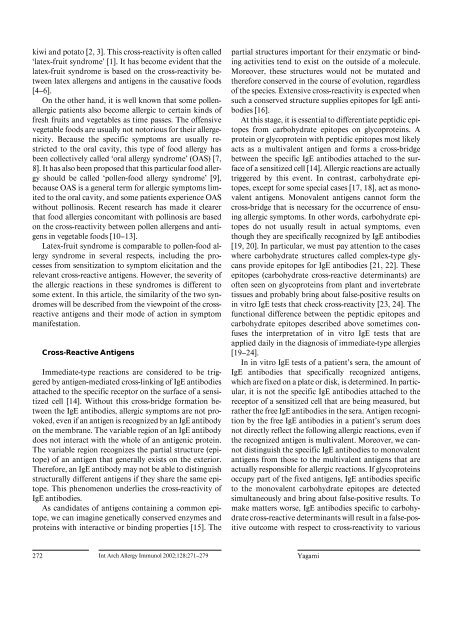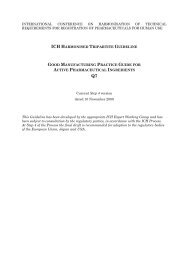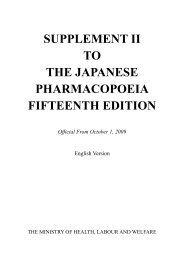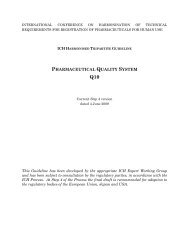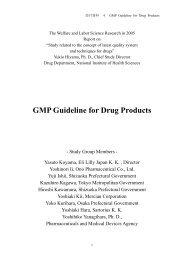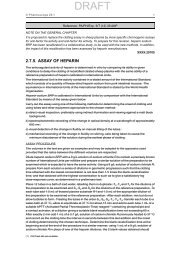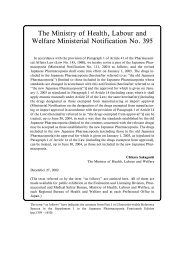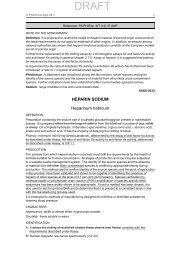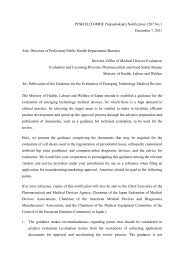Allergies to cross-reactive plant proteins. Latex-fruit ... - NIHS
Allergies to cross-reactive plant proteins. Latex-fruit ... - NIHS
Allergies to cross-reactive plant proteins. Latex-fruit ... - NIHS
Create successful ePaper yourself
Turn your PDF publications into a flip-book with our unique Google optimized e-Paper software.
kiwi and pota<strong>to</strong> [2, 3]. This <strong>cross</strong>-reactivity is often called<br />
‘latex-<strong>fruit</strong> syndrome’ [1]. It has become evident that the<br />
latex-<strong>fruit</strong> syndrome is based on the <strong>cross</strong>-reactivity between<br />
latex allergens and antigens in the causative foods<br />
[4–6].<br />
On the other hand, it is well known that some pollenallergic<br />
patients also become allergic <strong>to</strong> certain kinds of<br />
fresh <strong>fruit</strong>s and vegetables as time passes. The offensive<br />
vegetable foods are usually not no<strong>to</strong>rious for their allergenicity.<br />
Because the specific symp<strong>to</strong>ms are usually restricted<br />
<strong>to</strong> the oral cavity, this type of food allergy has<br />
been collectively called ‘oral allergy syndrome’ (OAS) [7,<br />
8]. It has also been proposed that this particular food allergy<br />
should be called ‘pollen-food allergy syndrome’ [9],<br />
because OAS is a general term for allergic symp<strong>to</strong>ms limited<br />
<strong>to</strong> the oral cavity, and some patients experience OAS<br />
without pollinosis. Recent research has made it clearer<br />
that food allergies concomitant with pollinosis are based<br />
on the <strong>cross</strong>-reactivity between pollen allergens and antigens<br />
in vegetable foods [10–13].<br />
<strong>Latex</strong>-<strong>fruit</strong> syndrome is comparable <strong>to</strong> pollen-food allergy<br />
syndrome in several respects, including the processes<br />
from sensitization <strong>to</strong> symp<strong>to</strong>m elicitation and the<br />
relevant <strong>cross</strong>-<strong>reactive</strong> antigens. However, the severity of<br />
the allergic reactions in these syndromes is different <strong>to</strong><br />
some extent. In this article, the similarity of the two syndromes<br />
will be described from the viewpoint of the <strong>cross</strong><strong>reactive</strong><br />
antigens and their mode of action in symp<strong>to</strong>m<br />
manifestation.<br />
Cross-Reactive Antigens<br />
Immediate-type reactions are considered <strong>to</strong> be triggered<br />
by antigen-mediated <strong>cross</strong>-linking of IgE antibodies<br />
attached <strong>to</strong> the specific recep<strong>to</strong>r on the surface of a sensitized<br />
cell [14]. Without this <strong>cross</strong>-bridge formation between<br />
the IgE antibodies, allergic symp<strong>to</strong>ms are not provoked,<br />
even if an antigen is recognized by an IgE antibody<br />
on the membrane. The variable region of an IgE antibody<br />
does not interact with the whole of an antigenic protein.<br />
The variable region recognizes the partial structure (epi<strong>to</strong>pe)<br />
of an antigen that generally exists on the exterior.<br />
Therefore, an IgE antibody may not be able <strong>to</strong> distinguish<br />
structurally different antigens if they share the same epi<strong>to</strong>pe.<br />
This phenomenon underlies the <strong>cross</strong>-reactivity of<br />
IgE antibodies.<br />
As candidates of antigens containing a common epi<strong>to</strong>pe,<br />
we can imagine genetically conserved enzymes and<br />
<strong>proteins</strong> with interactive or binding properties [15]. The<br />
partial structures important for their enzymatic or binding<br />
activities tend <strong>to</strong> exist on the outside of a molecule.<br />
Moreover, these structures would not be mutated and<br />
therefore conserved in the course of evolution, regardless<br />
of the species. Extensive <strong>cross</strong>-reactivity is expected when<br />
such a conserved structure supplies epi<strong>to</strong>pes for IgE antibodies<br />
[16].<br />
At this stage, it is essential <strong>to</strong> differentiate peptidic epi<strong>to</strong>pes<br />
from carbohydrate epi<strong>to</strong>pes on glyco<strong>proteins</strong>. A<br />
protein or glycoprotein with peptidic epi<strong>to</strong>pes most likely<br />
acts as a multivalent antigen and forms a <strong>cross</strong>-bridge<br />
between the specific IgE antibodies attached <strong>to</strong> the surface<br />
of a sensitized cell [14]. Allergic reactions are actually<br />
triggered by this event. In contrast, carbohydrate epi<strong>to</strong>pes,<br />
except for some special cases [17, 18], act as monovalent<br />
antigens. Monovalent antigens cannot form the<br />
<strong>cross</strong>-bridge that is necessary for the occurrence of ensuing<br />
allergic symp<strong>to</strong>ms. In other words, carbohydrate epi<strong>to</strong>pes<br />
do not usually result in actual symp<strong>to</strong>ms, even<br />
though they are specifically recognized by IgE antibodies<br />
[19, 20]. In particular, we must pay attention <strong>to</strong> the cases<br />
where carbohydrate structures called complex-type glycans<br />
provide epi<strong>to</strong>pes for IgE antibodies [21, 22]. These<br />
epi<strong>to</strong>pes (carbohydrate <strong>cross</strong>-<strong>reactive</strong> determinants) are<br />
often seen on glyco<strong>proteins</strong> from <strong>plant</strong> and invertebrate<br />
tissues and probably bring about false-positive results on<br />
in vitro IgE tests that check <strong>cross</strong>-reactivity [23, 24]. The<br />
functional difference between the peptidic epi<strong>to</strong>pes and<br />
carbohydrate epi<strong>to</strong>pes described above sometimes confuses<br />
the interpretation of in vitro IgE tests that are<br />
applied daily in the diagnosis of immediate-type allergies<br />
[19–24].<br />
In in vitro IgE tests of a patient’s sera, the amount of<br />
IgE antibodies that specifically recognized antigens,<br />
which are fixed on a plate or disk, is determined. In particular,<br />
it is not the specific IgE antibodies attached <strong>to</strong> the<br />
recep<strong>to</strong>r of a sensitized cell that are being measured, but<br />
rather the free IgE antibodies in the sera. Antigen recognition<br />
by the free IgE antibodies in a patient’s serum does<br />
not directly reflect the following allergic reactions, even if<br />
the recognized antigen is multivalent. Moreover, we cannot<br />
distinguish the specific IgE antibodies <strong>to</strong> monovalent<br />
antigens from those <strong>to</strong> the multivalent antigens that are<br />
actually responsible for allergic reactions. If glyco<strong>proteins</strong><br />
occupy part of the fixed antigens, IgE antibodies specific<br />
<strong>to</strong> the monovalent carbohydrate epi<strong>to</strong>pes are detected<br />
simultaneously and bring about false-positive results. To<br />
make matters worse, IgE antibodies specific <strong>to</strong> carbohydrate<br />
<strong>cross</strong>-<strong>reactive</strong> determinants will result in a false-positive<br />
outcome with respect <strong>to</strong> <strong>cross</strong>-reactivity <strong>to</strong> various<br />
272 Int Arch Allergy Immunol 2002;128:271–279 Yagami


